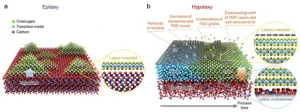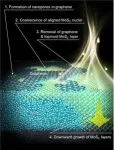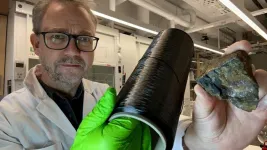(Press-News.org) College of Engineering at Seoul National University announced that a research team led by Professor Gwan-Hyoung Lee from the Department of Materials Science and Engineering, in collaboration with the research teams of Professors Hyejin Jang and Jeong Woo Han from the same department, has successfully developed the new synthesis technology of 2D semiconductors. This groundbreaking technique enables the direct growth of wafer-scale single-crystal 2D semiconductors on various substrates.
The research were published in "Nature," the world's most prestigious academic journal, on February 20th.
With the advancement of artificial intelligence (AI) technology, the demand for enhanced semiconductor performance has increased, along with active research on reducing power consumption in semiconductor devices. As a result, new semiconductor materials to replace conventional silicon are gaining attention. Among them, 2D materials such as transition metal dichalcogenides (TMDs) have been highlighted as next-generation semiconductors due to their thin structure and excellent electrical properties. However, there is currently a lack of mass production technology to synthesize them in high quality and utilize them industrially.
The most promising synthesis method to date, chemical vapor deposition (CVD), suffers from issues, such as degradation of electrical properties and the necessity of transferring grown TMDs to different substrates, adding extra complexity to the process. Additionally, the "epitaxy" method, which grows TMDs on highly crystalline substrates, also requires a transfer process and is limited to specific substrates. Consequently, the development of advanced 3D integration technology based on high-quality TMDs has emerged as a crucial challenge in the modern semiconductor industry, further emphasizing the urgent need for a novel TMD synthesis method.
To address this issue, the research team developed a completely new growth method. They introduced an approach that leverages 2D materials, such as graphene and hexagonal boron nitride as templates, guiding TMD crystal alignment to enable the synthesis of perfectly single-crystalline TMD films on any substrate. This pioneering technique, named "Hypotaxy," was developed for the first time in the world. The name "Hypotaxy" was derived by combining "hypo" (meaning "downward") and "taxy" (meaning "arrangement"), reflecting the downward growth characteristic of the synthesized films.
This technology holds significant industrial potential as it allows the growth of single-crystal TMDs at a low temperature (400°C), making it compatible with existing semiconductor manufacturing processes. Additionally, the graphene template naturally dissappeaers without requiring post-removal process, and the thickness of the metal film can be precisely controlled to regulate the number of TMD layers. These distinguishing features set Hypotaxy apart from existing methods. Furthermore, semiconductor devices fabricated using TMDs synthesized through Hypotaxy demonstrated high charge carrier mobility and excellent device uniformity, indicating that Hypotaxy has great potential to contribute to the development of high-performance, high-integration 2D semiconductor devices and the commercialization of next-generation 2D semiconductors.
Beyond its application in 2D semiconductor growth, Hypotaxy is being recognized as an innovative technique applicable to the synthesis of all crystalline thin-film materials. By not only overcoming the limitations of traditional semiconductor fabrication methods but also enabling precise control over crystal orientation and structure through templating, this approach presents a groundbreaking method that has never been proposed before.
Professor Gwan-Hyoung Lee, who led the research, emphasized the significance of the study, stating, "The Hypotaxy technique that we have developed overcomes the limitations of epitaxy, a concept first proposed in the 1930s and a fundamental pillar of modern electronic device development." He further added, "Since Hypotaxy enables 3D integration, which is essential for next-generation AI semiconductors, I expect it will establish itself as a revolutionary approach in materials engineering.“
Donghoon Moon, the first author of the paper, reflected on the research process, saying, "The greatest challenge was breaking away from the conventional perception of epitaxy, which has been the standard for synthesizing various high-quality materials." He continued, "Just as Hypotaxy emerged from a counterintuitive perspective on epitaxy, I hope this achievement serves as a catalyst for groundbreaking research in areas such as new material development and the synthesis of novel lattice structures."
Currently pursuing his PhD at SNU's Department of Materials Science and Engineering, Donghoon Moon is focusing on synthesizing moiré structures, previously deemed impossible to synthesize, using the Hypotaxy technique. He is also applying Hypotaxy to various new materials that were previously challenging to synthesize in large-scale, high-quality formats. He plans to continue his research as a postdoctoral fellow in the future.
□ Introduction to the SNU College of Engineering
Seoul National University (SNU) founded in 1946 is the first national university in South Korea. The College of Engineering at SNU has worked tirelessly to achieve its goal of ‘fostering leaders for global industry and society.’ In 12 departments, 323 internationally recognized full-time professors lead the development of cutting-edge technology in South Korea and serving as a driving force for international development.
END
SNU researchers develop a new synthesis technology of single crystal 2D semiconductors, “Hypotaxy,” to enhance the commercialization of next-generation 2D semiconductors
Introduced the "Hypotaxy" technique for growth of wafer-scale single-crystal 2D semiconductors, overcoming the limitations of existing processes
2025-03-04
ELSE PRESS RELEASES FROM THIS DATE:
Graphene production method offers green alternative to mining
2025-03-04
Researchers in Sweden report a green alternative to reduce reliance on mining graphite, the raw source behind the next wonder material, graphene.
In the latest volume of the scientific journal Small, researchers at KTH Royal Institute of Technology say they have developed a reproducible and scalable method for producing graphene oxide (GO) nanosheets from commercial carbon fibers, marking a breakthrough in sustainable nanomaterial synthesis.
The process involves exfoliating carbon fibers with nitric acid, which provides high yields of one-atom-thick sheets of graphene oxide with characteristics comparable ...
Researchers discover a cause of leptin resistance—and how to reverse it
2025-03-04
Worldwide obesity rates have more than doubled since 1990, with nearly a billion people now falling into the category. Though a complex interplay of genes, diet, and environment contribute, 90% of cases share one thing in common: leptin resistance.
In lean individuals, fat cells produce the hormone leptin, which suppresses appetite. But in most individuals with obesity, this signal fails to register. Why this happens has been a mystery for more than three decades, ever since Jeffrey M. Friedman’s laboratory at the Rockefeller University cloned the leptin gene in 1994.
But now Bowen Tan, Kristina Hedbacker, ...
Heat from the sun affects seismic activity on Earth
2025-03-04
WASHINGTON, March 4, 2025 – Seismology has revealed much of the basics about earthquakes: Tectonic plates move, causing strain energy to build up, and that energy eventually releases in the form of an earthquake. As for forecasting them, however, there’s still much to learn in order to evacuate cities before catastrophes like the 2011 magnitude 9.0 Tōhoku earthquake that, in addition to causing a tsunami that led to the Fukushima nuclear disaster, resulted in more than 18,000 deaths.
In recent years, research has focused on a possible correlation between ...
Postoperative aspiration pneumonia among adults using GLP-1 receptor agonists
2025-03-04
About The Study: This cohort study found no significant association between the preoperative use of glucagon-like peptide-1 receptor agonists (GLP-1 RAs) and short-term postoperative aspiration pneumonia despite growing concerns about the adverse effects of these medications after surgery. This finding suggests that it may be beneficial to reassess the preoperative withholding guidelines for GLP-1 RAs.
Corresponding author: To contact the corresponding author, Eric L. Smith, M.D., email esmith@nebh.org.
To access the embargoed study: Visit our For The Media website at this link https://media.jamanetwork.com/
(doi: 10.1001/jamanetworkopen.2025.0081)
Editor’s ...
Perceived discrimination in health care settings and care delays in patients with diabetes and hypertension
2025-03-04
About The Study: The findings of this study suggest that higher perceived discrimination in health care settings is positively associated with delaying health care due to nervousness about seeing a health care professional. The largest mediation proportion observed was among younger adults and racial and ethnic minority groups. By prioritizing better patient-clinician communication, health care delays associated with patient apprehension related to perceived discrimination may be reduced.
Corresponding author: To contact the corresponding author, Maryam Jafari Bidgoli, ...
Postoperative outcomes following preweekend surgery
2025-03-04
About The Study: In this retrospective multi-institutional study, patients who underwent surgery immediately preceding the weekend had a significantly increased risk of complications, readmissions, and mortality compared with those treated after the weekend. Further study is needed to understand differences in care that may underpin these observations and ensure that patients receive high-quality care regardless of the day of the week.
Corresponding author: To contact the corresponding author, Raj Satkunasivam, M.D., ...
Nearly 4 of 10 Americans report sports-related mistreatment
2025-03-04
Nearly 40% of adult Americans say they’ve experienced some type of sport-related mistreatment in their lives, a new study shows.
Mistreatment ranged from psychological and emotional to physical and sexual. But most people who reported mistreatment experienced more than one kind, the research found.
And one-third of those who never even played organized sports reported sports-related mistreatment.
“Many people talk about how they hated middle school or high school because of recess or gym class and the abuse or shame they felt playing sports in that environment,” said Chris Knoester, co-author of the study and professor of sociology ...
School absence patterns could ID children with chronic GI disorders, research suggests
2025-03-04
Children who frequently miss school because of abdominal complaints are far more likely to be suffering from disorders of the gut-brain axis such as irritable bowel syndrome than diseases that can be detected with medical tests, new UVA Health Children’s research has found. The discovery could improve care for children with these common GI disorders and might spare them from a barrage of unproductive tests.
UVA’s Stephen M. Borowitz, MD, and fourth-year medical student Seth M. Tersteeg looked at school absenteeism as reported by parents who brought their children to UVA Health Children’s Pediatric Gastroenterology Clinic. Children who had missed more ...
Mount Sinai researchers identify molecular glues that protect insulin-producing cells from damage related to diabetes
2025-03-04
Researchers from the Icahn School of Medicine at Mount Sinai in New York have discovered a novel approach to protecting insulin-producing beta cells from the damaging effects of glucolipotoxicity—a harmful condition linked to the progression of type 2 diabetes (T2D). These findings, published on March 2, 2025 in Nature Communications, could lead to promising treatments targeting beta cell dysfunction.
For patients, this research could lead to new treatments that protect the insulin-producing cells in the pancreas, potentially ...
Study: Smartwatches could end the next pandemic
2025-03-04
Everyday smartwatches are extremely accurate in detecting viral infection long before symptoms appear — now, research shows how they could help stop a pandemic before it even begins.
Early detection of sickness is critical for preventing its spread — whether it’s COVID-19, influenza or the common cold. Yet, many illnesses are at their most contagious before people even know they’re sick. Research shows that 44 percent of COVID-19 infections were spread several days before the sufferer came down with symptoms.
Now, researchers at Aalto University, Stanford University and Texas A&M, have released a study that models how smartwatches ...
LAST 30 PRESS RELEASES:
Scalable and healable gradient textiles for multi‑scenario radiative cooling via bicomponent blow spinning
Research shows informed traders never let a good climate crisis go to waste
Intelligent XGBoost framework enhances asphalt pavement skid resistance assessment
Dual-function biomaterials for postoperative osteosarcoma: Tumor suppression and bone regeneration
New framework reveals where transport emissions concentrate in Singapore
NTP-enhanced lattice oxygen activation in Ce-Co catalysts for low-temperature soot combustion
Synergistic interface engineering in Cu-Zn-Ce catalysts for efficient CO2 hydrogenation to methanol
COVID-19 leaves a lasting mark on the human brain
Scientists use ultrasound to soften and treat cancer tumors without damaging healthy tissue
Community swimming program for Black youth boosts skills, sense of belonging, study finds
Specific depressive symptoms in midlife linked to increased dementia risk
An ‘illuminating’ design sheds light on cholesterol
Who is more likely to get long COVID?
Study showcases resilience and rapid growth of “living rocks”
Naval Research Lab diver earns Office of Naval Research 2025 Sailor of the Year
New Mayo-led study establishes practical definition for rapidly progressive dementia
Fossil fuel industry’s “climate false solutions” reinforce its power and aggravate environmental injustice
Researchers reveal bias in a widely used measure of algorithm performance
Alcohol causes cancer. A study from IOCB Prague confirms damage to DNA and shows how cells defend against it
Hidden viruses in wastewater treatment may shape public health risks, study finds
Unlock the power of nature: how biomass can transform climate mitigation
Biochar reshapes hidden soil microbes that capture carbon dioxide in farmland
Reducing saturated fat intake shows mortality benefit, but only in high-risk individuals
Manta rays create mobile ecosystems, study finds
Study: Mixed results in using lipoic acid to treat progressive multiple sclerosis
Norbert Holtkamp appointed director of Fermi National Accelerator Laboratory
New agentic AI platform accelerates advanced optics design
Biologists discover neurons use physical signals — not electricity — to stabilize communication
Researchers discover that a hormone can access the brain by hitchhiking
University of Oklahoma researcher awarded funding to pursue AI-powered material design
[Press-News.org] SNU researchers develop a new synthesis technology of single crystal 2D semiconductors, “Hypotaxy,” to enhance the commercialization of next-generation 2D semiconductorsIntroduced the "Hypotaxy" technique for growth of wafer-scale single-crystal 2D semiconductors, overcoming the limitations of existing processes





